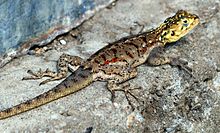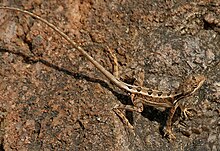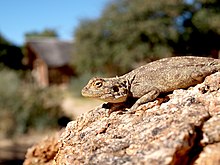Agamidae
| Agamidae Temporal range:
| |
|---|---|

| |
| Male Mwanza flat-headed rock agama (Agama mwanzae), in the Serengeti, Tanzania | |
| Scientific classification | |
| Domain: | Eukaryota |
| Kingdom: | Animalia |
| Phylum: | Chordata |
| Class: | Reptilia |
| Order: | Squamata |
| Suborder: | Iguania |
| Clade: | Acrodonta |
| Family: | Agamidae Gray, 1827[1] |
| Subfamilies | |
|
6, see text | |
Agamidae is a
Overview
This group of lizards includes some more popularly known, such as the domesticated
One of the key distinguishing features of the agamids is their teeth, which are borne on the outer rim of their mouths (acrodonts), rather than on the inner side of their jaws (pleurodonts). This feature is shared with the chameleons and the tuatara, but is otherwise unusual among lizards. Agamid lizards are generally diurnal, with good vision, and include a number of arboreal species, in addition to ground- and rock-dwellers. Most need to bask in the sun to maintain elevated body temperatures, meaning they are heliothermic. They generally feed on insects and other arthropods (such as spiders), although for some larger species, their diet may include small reptiles or mammals, nestling birds, and flowers or other vegetable matter.[10]
Reproduction
The great majority of agamid species are
Systematics and distribution



Very few studies of the Agamidae have been conducted. The first comprehensive assessment was by Moody (1980)[12] followed by a more inclusive assessment by Frost and Etheridge (1989).[13] Subsequent studies were based on mitochondrial DNA loci by Macey et al. (2000)[14] and Honda et al. (2000)[15] and also by sampling across the Agamidae by Joger (1991).[16] Few other studies focused on clades within the family, and the Agamidae have not been as well investigated as the Iguanidae.
The agamids show a curious distribution. They are found over much of the Old World, including continental Africa, Australia, southern Asia, and sparsely in warmer regions of Europe. They are, however, absent from Madagascar and the New World. The distribution is the opposite of that of the iguanids, which are found in just these areas, but absent in areas where agamids are found. A similar faunal divide is found in between the boas and pythons.[17]
Subfamilies
Among the Agamidae, six
- Agaminae (Africa, Europe and south Asia)
- Amphibolurinae (Australia and New Guinea, one species in Southeast Asia)
- Draconinae (South and Southeast Asia)
- Hydrosaurinae(Hydrosaurus, Papua New Guinea, the Philippines, and Indonesia)
- Leiolepidinae(Leiolepis, Southeast Asia)
- Uromasticinae(Saara and Uromastyx, Africa and South Asia)
Evolutionary history
The oldest known unambiguous agamid is
Predator responses
Body temperature helps determine the physiological state of these lizards and affects their predator responses. A positive correlation is seen between a flight response (running speed) and body temperature of various agamid species.[23] At higher body temperatures, these lizards tend to flee quickly from predators, whereas at lower temperatures, they tend to have a reduced running speed and show an increased fight response, where they are more likely to be aggressive and attack predators.
Certain physical features of some lizards of these species, such as
References
- ^ Dahms Tierleben. www.dahmstierlrben.de/systematik/Reptilien/Squamata/Iguania/agamidae.
- .
- ^ Ananjeva, Natalia B.; Bryan L. Stuart (2001). "The Agamid lizard Ptyctolaemus phuwtilmensis Manthey and Nabhitabhata, 1991 from Thailand and Laos represents a new genus". Russian Journal of Herpetology. 8 (3). Folium Publishing Company: 165–170.
- S2CID 13413178.
- .
- PMID 10737400.
- PMID 30621580.
- PMID 30773845.
- S2CID 203652748.
- OCLC 35576956.
- ISBN 978-0-12-178560-4.
- ^ Moody, S. M. (1980). Phylogenetic relationships and historical biogeographical relationships of the genera in the family Agamidae (Reptilia: Lacertilia) (PhD). Ann Arbor: University of Michigan. 8017324.
- ^ Frost, Darrel R.; Richard Etheridge (28 September 1989). "A phylogenetic analysis and taxonomy of iguanian lizards (Reptilia: Squamata)". University of Kansas Museum of Natural History Miscellaneous Publications. 81. University of Kansas Museum of Natural History: 1–65. Retrieved 5 January 2012.
- PMID 12118408..
- S2CID 53607509.
- JSTOR 1446389.
- ISBN 9781107041028.
- ^ Agamidae, UniProt Taxonomy
- .
- S2CID 233704307.
- PMID 27703708.
- S2CID 253349389.
- S2CID 53182102.
- .
External links
- Agamidae (all species) at The Reptile Database
- "Agamidae". Atlas of Living Australia.
